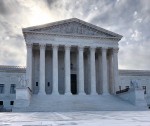The Supreme Court Unanimously Protects Religious Foster Agencies
The Supreme Court’s unanimous decision in Fulton v. City of Philadelphia is proof positive that protecting religious liberty does not have to be controversial, and that there are commonsense solutions to hot-button debates. Making space for same-sex couples to foster does not mean you have to exclude “exemplary” foster parents like Sharonell Fulton, or force religious agencies to shut their doors. From the day this case began, Catholic Social Services’ position was clear: as a Catholic agency, it cannot endorse same-sex couples as foster parents. But this fact had never prevented a single same-sex couple from fostering. As the Supreme Court explained, “CSS seeks only an accommodation that will allow it to continue serving the children of Philadelphia in a manner consistent with its religious beliefs; it does not seek to impose those beliefs on anyone else.”
Imposing beliefs is what Philadelphia officials tried to do. They demanded that the Catholic agency change its policies – rooted in millennia-old beliefs on marriage – or close its doors. Worst of all, Philadelphia was willing to let hundreds of kids stay in group homes or institutions rather than place them with loving families who partner with Catholic Social Services. Just days before the city’s ultimatum, it put out an urgent call for hundreds more foster families to fill the shortfall. The city was willing to impose its own orthodoxy and do it at the expense of foster kids.
The Supreme Court’s unanimous decision shows that we are still capable of live-and-let-live solutions. As a result, it will be easier for foster children across the country to find loving homes. In Philadelphia, for example, foster parents like Sharonell Fulton and Toni Simms-Busch will again be able to care for children in need in partnership with Catholic Social Services. That won’t stop gay couples in Philadelphia – or anywhere else – from fostering. But it does mean faith-affirming agencies nationwide no longer need to fear government sanction for serving all children in need consistent with their sincere religious beliefs.
The Supreme Court’s decision is also a major victory for religious freedom and for religious minorities in particular. The Court made clear that when the government has discretion, it can’t use that discretion to crack down on religious exercise – at least not without a compelling reason. Put simply, the Supreme Court mandated a rule of fairness: the government must treat religious exercise at least as well as it treats other sorts of secular activity.
How does that work in practice? Two examples might help explain. Suppose the Navy requires all its sailors to be clean shaven, but makes an exception to keep up morale, or for sailors who get skin problems from shaving. The Free Exercise Clause, as Fulton explained, says that if the Navy is going to bend the rules for secular reasons, it should also respect the religious beliefs of Orthodox Jews or Sikhs whose faith requires them to wear a beard.
Similarly, during the COVID-19 pandemic, several state and local governments allowed casinos, big box stores, salons, non-essential retailers, and numerous other secular businesses to reopen, but kept houses of worship shuttered. As the Supreme Court explained, governments are not allowed to prioritize economic activities over religious worship.
We live in contentious times. But the court’s unanimous decision reminds us that we also have constitutional guardrails that help us all to live together in harmony and work together for the common good – even when we disagree about important matters. Before this case, the city and the church had cooperated together to find loving homes for children in need. Thanks to the First Amendment and a unanimous court, they can now get back to that important work.
Mark Rienzi is the president of the Becket Fund for Religious Liberty and professor of law at Catholic University of America. Rienzi is also a scholar with the Religious Freedom Institute's Freedom of Religious Institutions in Society Project.






